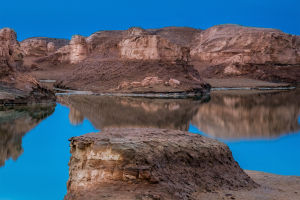Auroras are one of the most breathtaking natural phenomena that occur in the sky. They are caused by the collision of charged particles from the sun with atoms in the Earth's atmosphere.
This collision results in a stunning display of light that can be seen in many parts of the world, making it a sight worth seeing at least once in a lifetime.
One of the most famous destinations to view the auroras is Iceland. The country is known for its vast and remote landscapes, offering spectacular opportunities to witness this natural phenomenon.
The picturesque Goðafoss waterfall, located just 45 minutes from Akureyri, is a great spot to watch the auroras in action. The cascading water from the waterfall combined with the glowing green and purple lights of the auroras make for a truly mesmerizing sight.
Apart from the auroras, Iceland is also home to another natural wonder: The ice waterfall. These majestic formations are created when water cascading down a rock face or cliff freezes, resulting in a frozen waterfall. These stunning structures are a true testament to the beauty and power of nature, and Iceland boasts some of the most incredible examples of ice waterfalls.
However, it's not just Iceland that offers a chance to witness the beauty of ice waterfalls. Colorado's Ouray Ice Park is home to one of the largest man-made ice waterfalls in the world.
This park is a must-visit for adventure seekers and nature enthusiasts alike, offering a unique opportunity to see these magnificent formations up close.
The beauty of the auroras and ice waterfalls is truly breathtaking, and experiencing them in person is an unforgettable experience. The combination of the Northern Lights dancing across the sky and the frozen waterfalls glittering in the sunlight or moonlight is a sight that will stay with you forever.
When planning your trip to see the auroras or ice waterfalls, it's important to consider a few factors. First and foremost, the weather plays a significant role in your ability to witness these natural phenomena.
The best time to see the auroras is during the winter months when the nights are longer, and the skies are clearer. However, this also means that the temperatures can drop significantly, so make sure you're dressed appropriately and have the right gear to keep you warm.
Similarly, if you plan on visiting ice waterfalls, it's important to be mindful of the weather conditions. The ice formations can be fragile and can melt rapidly if the temperatures rise. It's always best to check with local authorities or tour guides to ensure that the ice waterfall is safe to visit.
Another essential factor to consider is the location. While Iceland and Colorado are popular destinations for viewing the auroras and ice waterfalls, many other places around the world offer similar experiences.
Norway, Canada, and Alaska are just a few examples of destinations known for their stunning displays of the Northern Lights. Similarly, Switzerland, France, and Italy have some of the most impressive ice formations in the world.
When planning your trip, it's essential to research the location to determine the best time and place to witness these natural wonders. Many tour companies offer guided tours and excursions specifically designed to see these natural phenomena.
These tours can provide valuable insight into the science and history behind these phenomena and offer a chance to experience them with a knowledgeable guide.
The beauty of the auroras and ice waterfalls is truly awe-inspiring. These natural phenomena are a reminder of the beauty and power of nature and offer a unique and unforgettable experience for those lucky enough to witness them. So, take the time to plan your trip, dress appropriately, and immerse yourself in the beauty of nature's most captivating displays.


